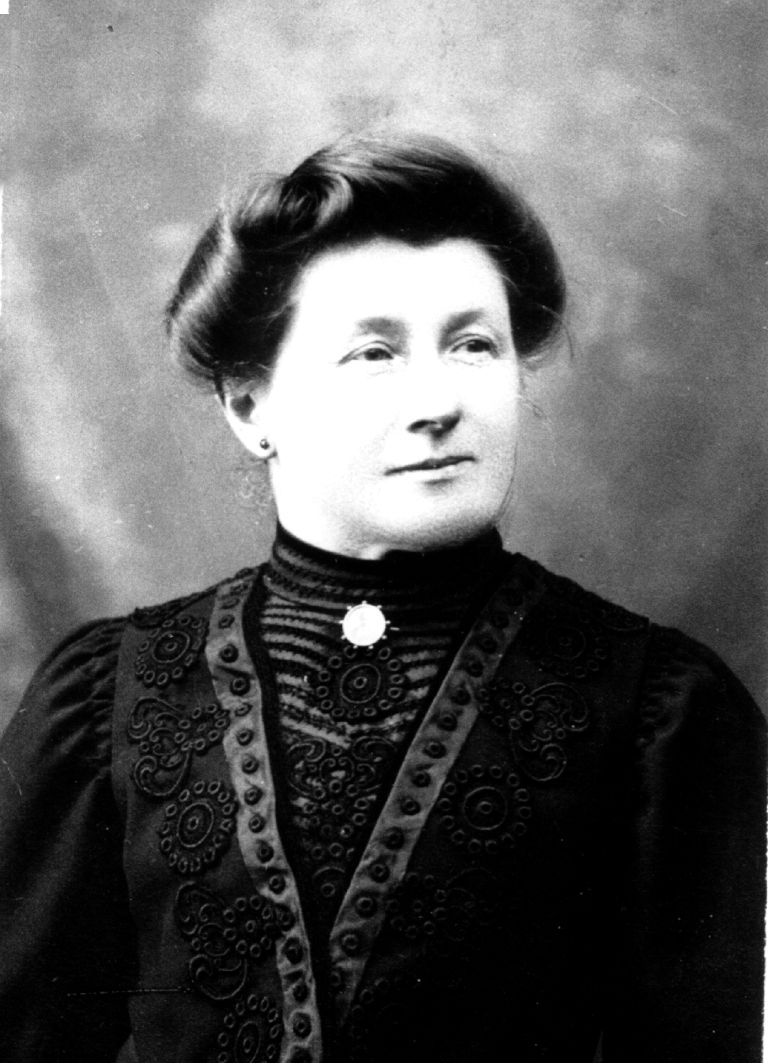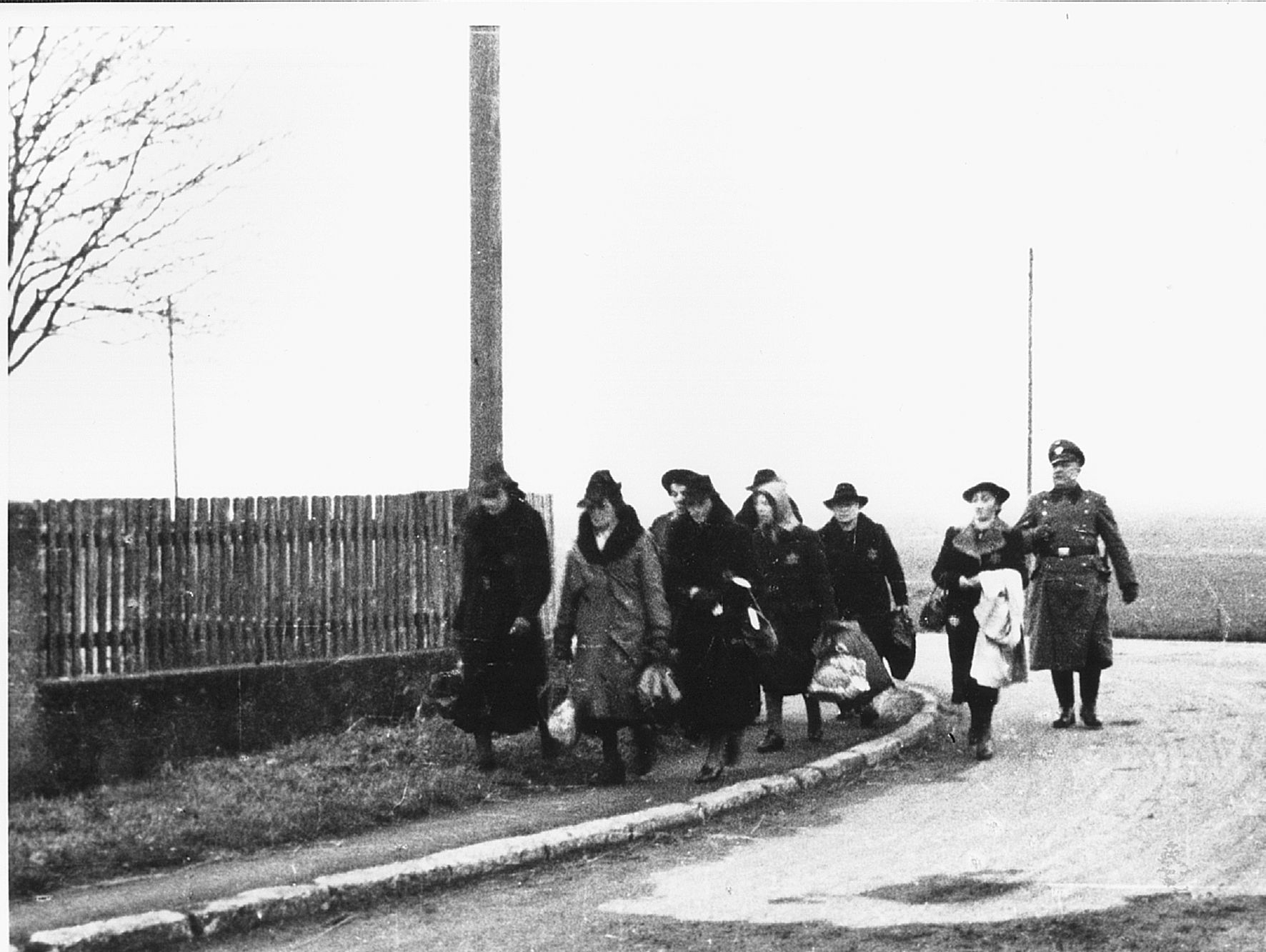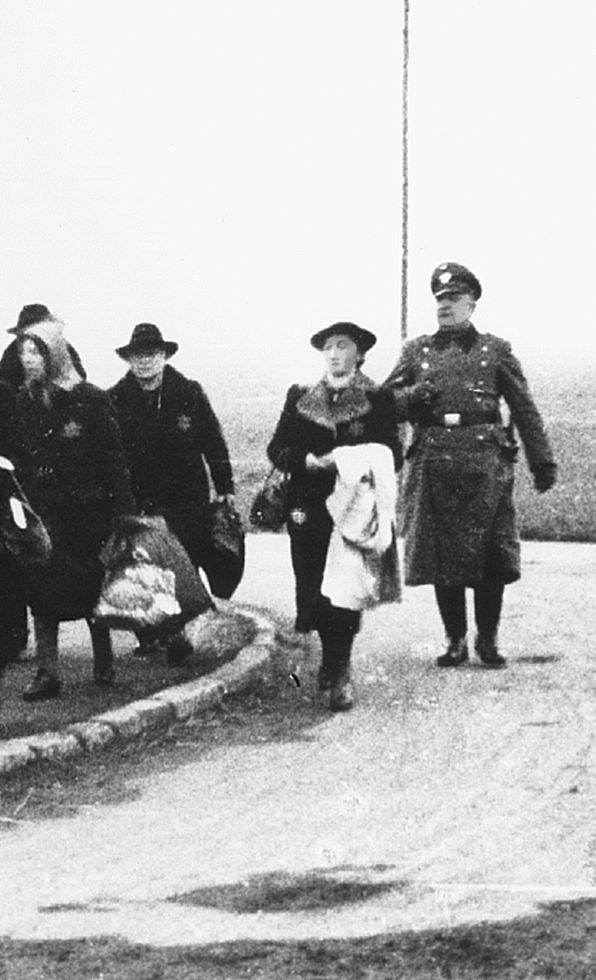 ISAY,
Rosa and Karoline,
ISAY,
Rosa and Karoline,
The Jewish
Community
of
La
Book Pages 308 - 311
DR . ANTJE KÖHLERSCHMIDT
[Isidor Isay, born December 30, 1863 in Schweich, near Trier, died June 14, 1891 in Pittsburg], OO Rosa, neé Bernheim, born September 26, 1863 in Laupheim, died July 24, 1939
– Karoline, known as Carry, Isay, born April 16, 1891 in Pittsburg, deported to Riga on November 28, 1941, perished on December 15, 1941 in Riga.

The picture above presents quite a striking portrait of
Rosa Isay. Not only does she seem rather dressed up for the occasion,
but she also has a calm, friendly and confident gaze. Unfortunately, as
the biography of Rosa Isay has only been partially constructible, which
character traits and behavior were actually unique to her will remain
unknown. But the few known details suggest that she led quite an
eventful life. Sadly, many questions remain unanswered, which leaves a
lot of room for interpretation.
Rosa was born in Laupheim on December 26, 1863 as the
daughter of Babette Bernheim, a single mother (1838-1893). Her mother
was known as Peppi Bernheim and is buried under this name in the Jewish
cemetery in Laupheim, in grave S 17/3. Rosa grew up in Laupheim. On June
15, 1890, she married Isidor Isay in Pittsburg, who was born on December
30, 1863 in Schweich, near Trier. He was also from Germany, but from the
Prussian area, as a remark in the registry record reveals. It is
completely unclear how and where the two met and why she moved to
Pittsburg, U.S.A.
The emigration and immigration of Jewish citizens of Laupheim, but also
from other rural Jewish communities, started in the 19th
century. Nevertheless, the Jewish community in Laupheim continued to
grow until 1869, at which point it consisted of 843 people. The
following statistics, however, show a significant decrease thereafter:
in
1886: 570;
in 1900: 443;
in 1910: 348;
and in 1933:
235. Destinations of the Jewish citizens of Laupheim were bigger
German cities like Ulm, Munich or Stuttgart, which offered better living
and working conditions. The United States was also a destination for the
emigrants, as it embodied the hopes of personal and religious freedom
and the American dream of happiness and success. These hopes were
unfortunately not to be fulfilled for Isidor and Rosa Isay. The birth of
their daughter, Karoline Isay on April 16, 1891 in Pittsburg, was a
promising start, but only two months later, on June 14, 1891, Isidor
Isay died.
This stroke of fate might have led the young mother and her six month old daughter, who was known as Carry, to return to Laupheim in October 1891. Even though her husband’s relatives were living in Pittsburg, she preferred to move back to her hometown and her family. After all her mother was living in Laupheim.
As of October 1891 they were living at 59 Kapellenstrasse. The house had presumably been Peppi Bernheim’s parents’ house, and had therefore originally belonged to Leopold Bernheim and his wife Esther, neé Einstein. Nine of Peppi’s eleven siblings had died within a few days or weeks of their birth. Her two older brothers did reach adulthood and get married, but neither were buried in Laupheim. This suggests that they had left their hometown and Peppi Bernheim would have probably inherited her parent’s house. After Peppi died, Rosa Isay inherited it. Eventually, after Rosa’s death on July 24, 1939, the house was passed on to Rosa’s daughter Carry.
Very little is known about the lives of the women
of Laupheim. Carry Isay attended the Jewish
Volksschule (primary school) on Radstrasse. She is shown below on a
class photo from 1904 or 1905 with her teacher Mr. Haymann. She is the
girl in the second row from the top, second one from the right. This is
the only existing picture of her. According to city records, after
graduation she worked as a clerk and her mother, Rosa Isay, was a
teacher, but where she had been employed could not be determined. In an
interview from March 8, 1995, Pastor Burkert mentioned to Benigna
Schönhagen that the Isays had once lived next door to the Kirschbaum
sisters and across from the Burkert family. Carry used to work at the
Bergmann’s hair salon. The Isays and the Burkerts visited each other so
regularly that they were almost like housemates. The friendship between
the Burkerts and their Jewish neighbors was well known, which remained
steadfast during the period after 1933. After the war Rosa Burkert
helped the Isay relatives as an authorized representative in matters
regarding restitution.

Jewish Volksschule
1904/05,
from the left Irma
Kirschbaum,
Carry Isay,
teacher Max
Haymann
According to Pastor Burkert, his sister had sewn pieces
of gold, originating from friends in the United States, into Carry’s coat
before her deportation in November 1941. They had anticipated their fate and
declared: “We are never coming back!” They were all very sad. Considering
what they had been experiencing since 1933, including complete social
exclusion and the deprivation of rights, they had to fear the worst. After
her mother’s death, Carry Isay lived by herself in the house at 59
Kapellenstrasse. Although she did not sell the house, she was forced to move
to the Wendelinsgrube in October 1941. The barracks in the Wendelinsgrube
had neither electricity nor running water. Eyewitnesses reported that in
addition to miserable living conditions, the Jewish residents suffered
mainly from hunger. Her house was rented to pensioner Jakob Rieger as of
October 15, 1941.
Carry Isay was assigned to the first deportation to
Riga on November 28, 1941. The picture below was taken at the Laupheim West
train station. One could assume because of the childhood photo and her
resemblance to her mother that the woman next to the police officer is, with
the light coat on her arm, Carry Isay.


Photo of the Deportation from
Laupheim West train station, November 20, 1941
Carry Isay (???)
The so called “evacuation to the east” should have led
the victims, and those left behind, to believing that those being deported would
be relocated to the east. Starting at the collection camp at Killesberg in
Stuttgart, a train with 1013 people left on December 1, 1941. On December 4,
1941, the train reached its destination in Riga. On June 25, 1956, Carry Isay
was declared dead by the District Court of Laupheim. The date of her passing is
given as December 15, 1941. It is very likely, as with most of those deported
with her, that Carry was murdered in the mass executions shortly after her
arrival in Riga.
Upon deportation to the Reichskommissariat Ostland
(Nazi occupied regime in the Baltic States where Riga was located), the assets
of deported Jews became the property of the German Reich in accordance with the
Reichsbuergergesetz (Citizen Law in Nazi Germany) of November 25, 1941. Thus
Carry Isay’s house at 59 Kapellenstrasse was affected as well and the income
generated from her property went to the German Reich.
After 1945, Max, Louis, Adele and Albert Isay, the
siblings of Carry’s father, Isidor Isay, sought to clarify the fate of their
niece. Thanks to their efforts, an official death certificate was issued by the
District Court and the house on Kapellenstrasse was given back to its rightful
heirs in 1953. They eventually sold it with the help of realtor Josef Benzinger.
Bibliography and list of
sources:
Amtsgericht
Laupheim
GR
157/56.
Hecht,
Cornelia/Köhlerschmidt, Antje:
Die Deportation
der Juden
aus Laupheim.
Laupheim
2004,
S.
60. Interview
von
Frau Schönhagen
mit Pfarrer Burkert
vom 8.3.1995
(Museum zur
Geschichte von Cristen
und Juden, Schloss
Großlaupheim).
Schenk,
Georg: Die
Juden
in
Laupheim.
Aus:
Laupheim
1976.
S.
286 ff.
Staatsarchiv
Sigmaringen Wü
126/2
FA
BC 30.
Stadtachiv
Laupheim
F
9811-9899 Ia.
Stadtesamt
Laupheim,
Familienregisterband
V,
S.31
und
S.
308.